Attached files
| file | filename |
|---|---|
| 8-K - 8-K - MADRIGAL PHARMACEUTICALS, INC. | a16-8459_18k.htm |
| EX-99.1 - EX-99.1 - MADRIGAL PHARMACEUTICALS, INC. | a16-8459_1ex99d1.htm |
Exhibit 99.2
Synta Pharmaceuticals and Madrigal Pharmaceuticals Merger Agreement NASDAQ: SNTA April 14, 2016
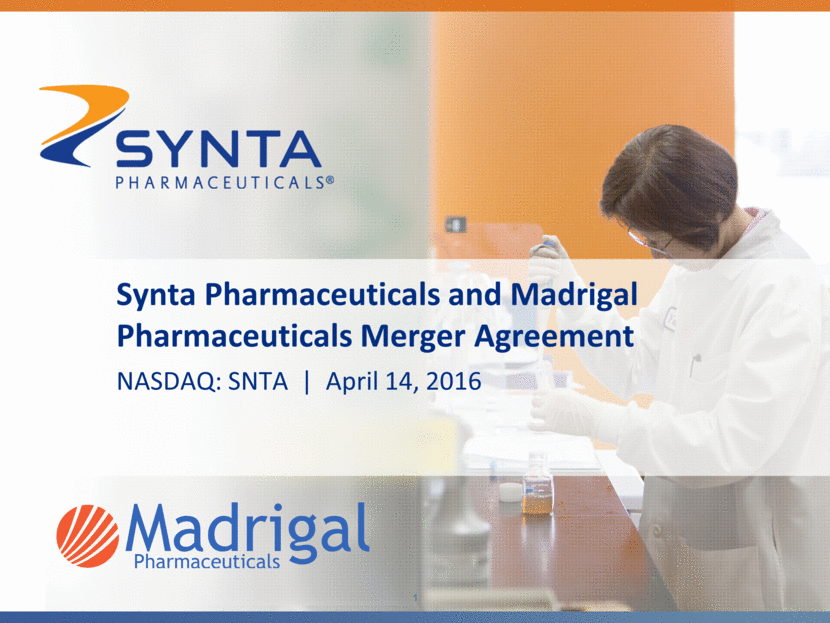
Forward-Looking Statements Any statements made in this press release relating to future financial or business performance, conditions, plans, prospects, trends, or strategies and other financial and business matters, including without limitation, whether and when our recently announced merger with Madrigal will close; the ability of the combined company to raise needed capital; the success of our merger with Madrigal, if consummated; the estimated size of the market for product candidates, the timing and success of the combined company’s development and commercialization of its anticipated product candidates; and the availability of alternative therapies for the combined company’s target market, are forward-looking statements within the meaning of the Private Securities Litigation Reform Act of 1995. In addition, when or if used in this press release, the words “may,” “could,” “should,” “anticipate,” “believe,” “estimate,” “expect,” “intend,” “plan,” “predict” and similar expressions and their variants, as they relate to Madrigal, Synta or the management of either company, before or after the aforementioned merger, may identify forward-looking statements. Madrigal and Synta caution that these forward-looking statements are subject to numerous assumptions, risks, and uncertainties, which change over time. Important factors that may cause actual results to differ materially from the results discussed in the forward-looking statements or historical experience include risks and uncertainties, including the timing and completion of the merger, including the parties’ ability to satisfy the closing conditions of the Merger Agreement with Madrigal, including the closing condition that Synta have a minimum net cash amount of $28.5 million, Synta’s continued listing on NASDAQ, the failure by Madrigal or Synta to secure and maintain relationships with collaborators, risks relating to clinical trials; risks relating to the commercialization, if any, of Madrigal or Synta proposed product candidates (such as marketing, regulatory, product liability, supply, competition, and other risks); dependence on the efforts of third parties; dependence on intellectual property; and risks that Madrigal or Synta may lack the financial resources and access to capital to fund proposed operations. Further information on the factors and risks that could affect Synta’s business, financial conditions and results of operations are contained in Synta’s filings with the U.S. Securities and Exchange Commission, which are available at www.sec.gov. The forward-looking statements represent the estimate of Madrigal and Synta as of the date hereof only, and Madrigal and Synta specifically disclaim any duty or obligation to update forward-looking statements.
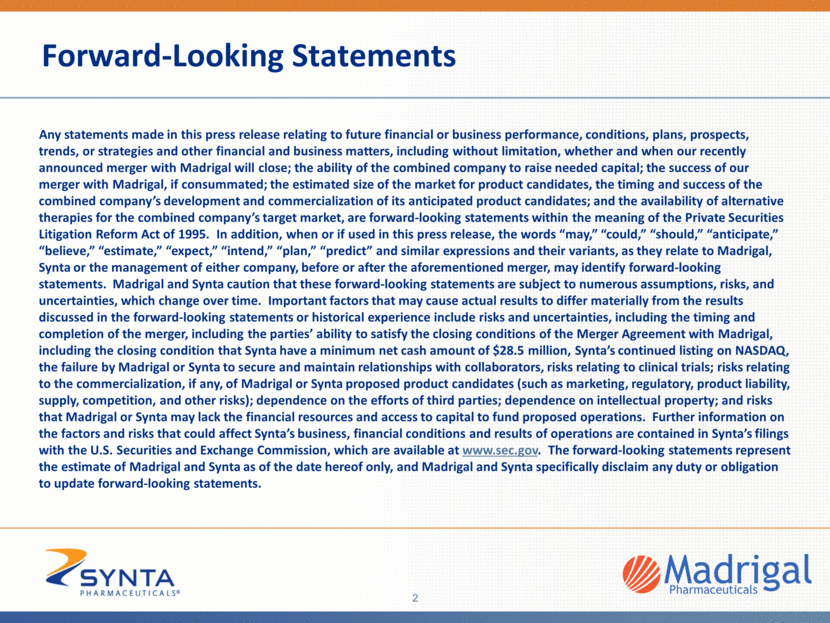
Additional Information about the Merger and Where to Find It This presentation does not constitute an offer to sell or the solicitation of an offer to buy any securities or a solicitation of any vote or approval. A definitive proxy statement and a proxy card will be filed with the SEC and will be mailed to Synta’s stockholders seeking any required stockholder approvals in connection with the proposed transactions. The proxy statement will contain important information about Synta, Madrigal, the transaction and related matters. BEFORE MAKING ANY VOTING OR INVESTMENT DECISION, INVESTORS AND STOCKHOLDERS ARE URGED TO READ THE PROXY STATEMENT (INCLUDING ANY AMENDMENTS OR SUPPLEMENTS THERETO) AND ANY OTHER RELEVANT DOCUMENTS THAT SYNTA MAY FILE WITH THE SEC WHEN THEY BECOME AVAILABLE BECAUSE THEY WILL CONTAIN IMPORTANT INFORMATION ABOUT THE PROPOSED TRANSACTIONS. Stockholders may obtain, free of charge, copies of the definitive proxy statement and any other documents filed by Synta with the SEC in connection with the proposed transactions at the SEC's website (http://www.sec.gov), at Synta’s website under the heading “Investors / SEC Filings”, or by directing a written request to: Synta Pharmaceuticals Corp., 45 Hartwell Avenue, Lexington, MA 02421, Attention: Wendy Rieder, Esq. Synta and its directors and executive officers and Madrigal and its directors and executive officers may be deemed to be participants in the solicitation of proxies from the stockholders of Synta in connection with the proposed transaction. Information regarding the special interests of these directors and executive officers in the merger will be included in the proxy statement referred to above. Additional information regarding the directors and executive officers of Synta is also included in Synta’s Definitive Proxy Statement on Schedule 14A relating to the 2015 Annual Meeting of Stockholders, which was filed with the SEC on April 30, 2015. This document is available free of charge at the SEC web site (www.sec.gov), at Synta’s website under the heading “Investors / SEC Filings”, or by directing a written request to Synta as described above.
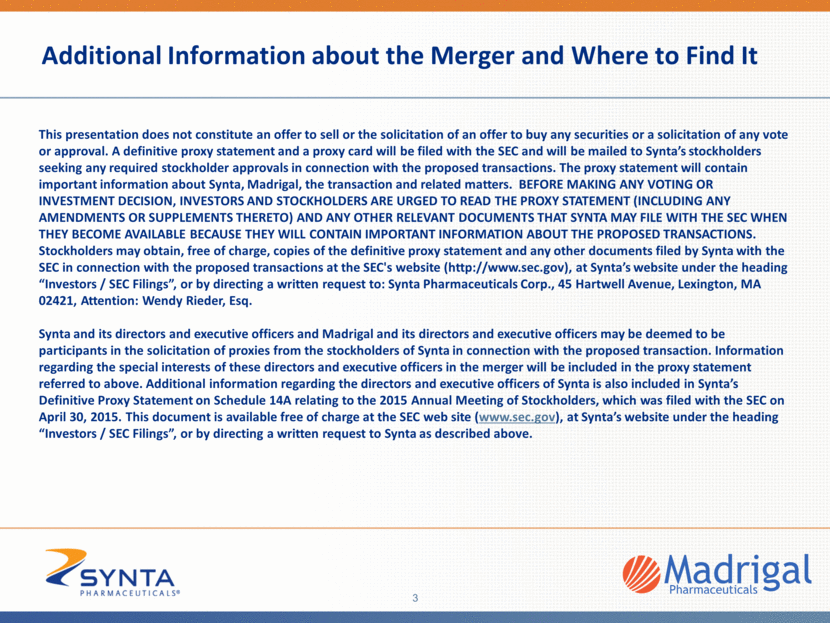
Synta-Madrigal Terms All-stock transaction: Synta to acquire all outstanding shares of Madrigal in exchange for approximately 253.9 million newly issued shares of Synta common stock Upon completion of the proposed acquisition, existing Synta shareholders will own 36.0% of the combined company and Madrigal shareholders will own 64.0% of the combined company Upon closing of the transaction, the combined company will be known as Madrigal Pharmaceuticals Investor syndicate committed to invest up to $9 million in Madrigal prior to the closing of the Merger Combined anticipated Synta cash balance and private placement provides sufficient cash to fund several clinical readouts The transaction has been approved by the boards of directors of both companies and Madrigal shareholders Expected to close by the end of 3Q 2016, subject to the approval of the stockholders of Synta as well as other customary closing conditions, including satisfaction of Synta having at least $28.5 million in net cash at closing
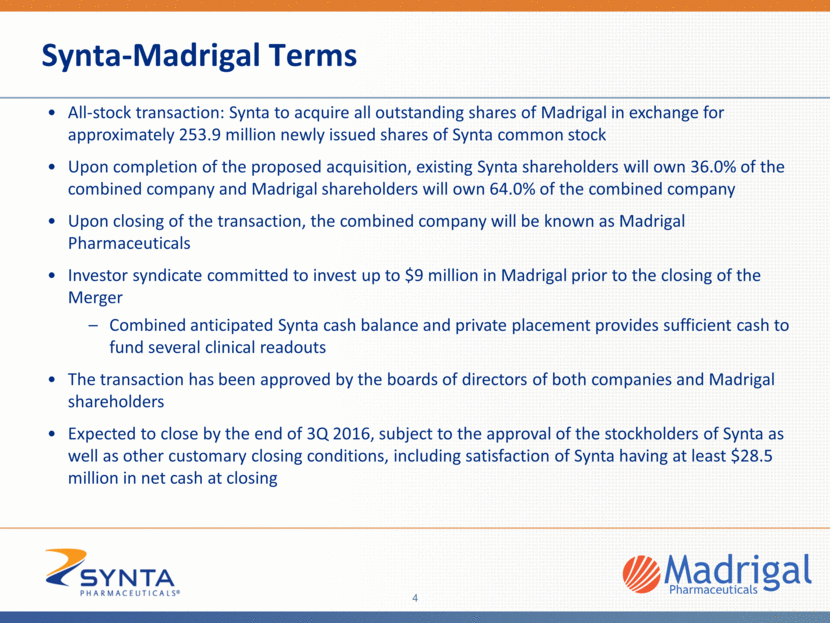
Synta-Madrigal Merger Agreement Follows Synta’s extensive review of strategic alternatives Combined company will be focused on the development of novel small-molecule drugs addressing major unmet needs in cardiovascular-metabolic diseases and NASH Lead compound, MGL-3196, is a first-in-class, Phase 2-ready, once-daily, oral, liver-directed selective thyroid hormone receptor-ß (THR-ß) agonist Initial indications are NASH and familial hypercholesterolemia; possibility to expand indications Combined company is a potentially attractive therapeutic, commercial and investment opportunity Possibly multiple value creating events over the next 18 months Historical Synta assets offer potential opportunity for monetization
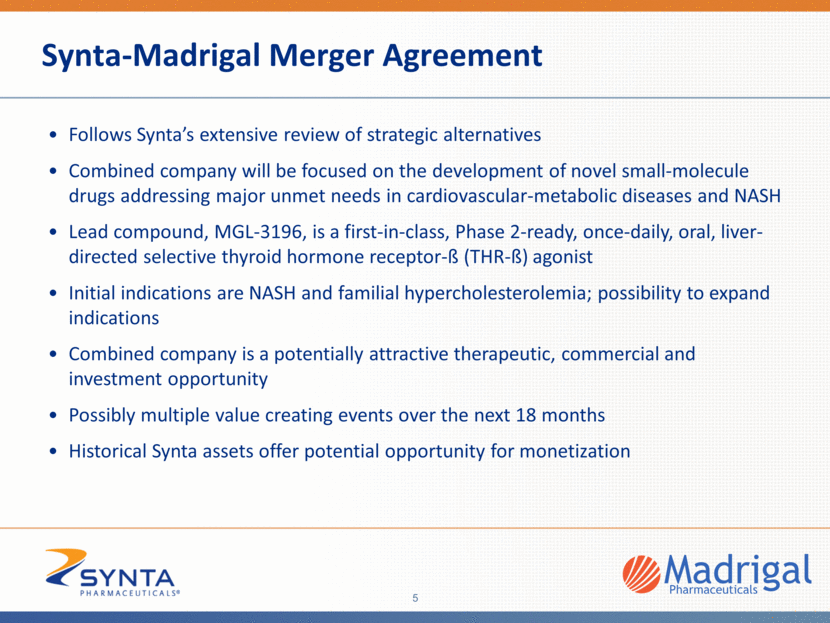
Synta-Madrigal Leadership Combined company will be led by an experienced management team with multiple successful NDA/EMAs and marketed products Paul Friedman, M.D. - Chairman and CEO Former CEO of Incyte Pharmaceuticals; former President of DuPont Pharmaceuticals Research Rebecca Taub, M.D. - Chief Medical Officer, Executive Vice President, R&D Led teams that discovered Eliquis and MGL-3196, Madrigal’s lead compound Recognized expert in liver regeneration and diseases of the liver Marc Scheenbaum - Chief Financial Officer SVP, CFO of Synta since 2014 Board comprised of seven directors: five from Madrigal, one from Synta, and one mutually agreed upon designee Corporate headquarters will be located in the Philadelphia area
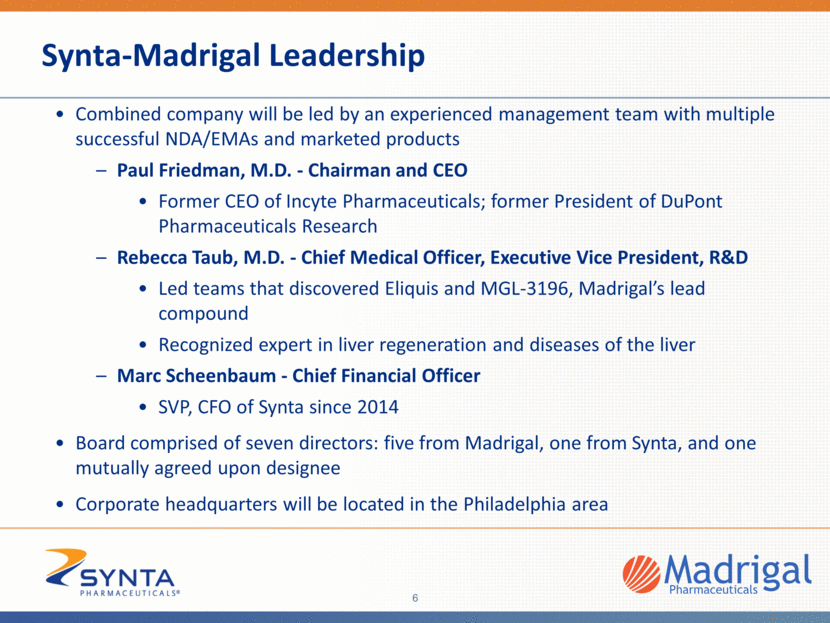
Paul A. Friedman, M.D.

Building a Platform in Lipid and Liver Disorders with MGL-3196, a First-in-Class Thyroid Hormone-β (THR-β) Agonist Lead compound, MGL-3196, a Phase 2-ready liver-directed thyroid hormone receptor-β (THR-β) agonist Once-daily oral dosing Favorable safety and efficacy profile World-wide patent exclusivity First-in-Class Approach Streamlined Clinical Development Plan in Genetic Lipid Disorder Directly targets lipotoxicity and metabolic defects in NASH Strong disease link: THR-β receptor deficiency in NASH livers Supported by preclinical and clinical data Differentiation: CV benefit, MGL-3196 LDL cholesterol lowering up to 30% in humans Significant Opportunity in NASH Heterozygous and homozygous familial hypercholesterolemia (HeFH, HoFH) Affect up to 1:200 and 1:250,000 patients world-wide MGL-3196 demonstrated robust efficacy in LDL lowering Clinically validated, multiple complementary lipid pathways Potentially fast to market, early Phase 2 favorable safety and efficacy profile
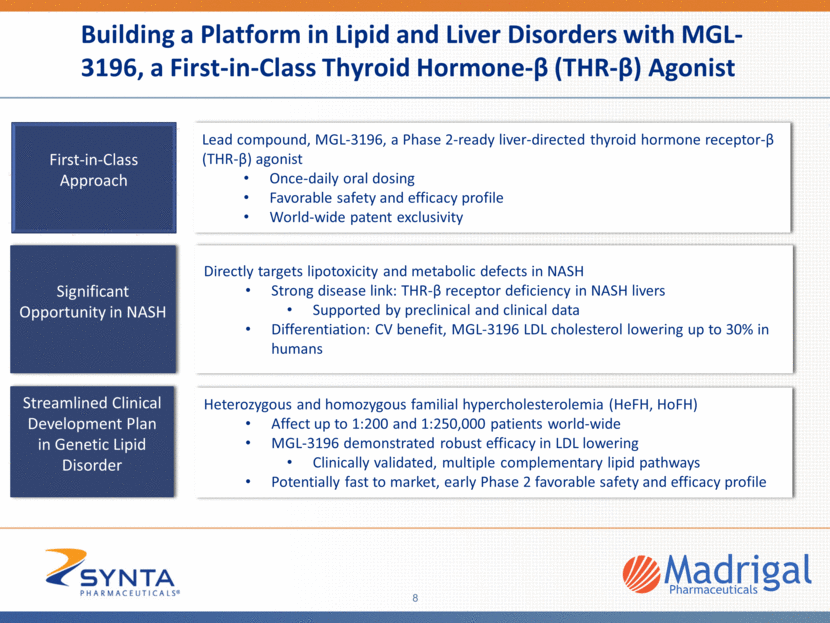
Rebecca Taub, M.D.

MGL-3196, a First-in-Class Liver-Directed THR- β Agonist We believe MGL-3196 is the first bona fide THR-β selective molecule Discovery of MGL-3196 and backups at Roche utilized a novel functional assay that went beyond what previous companies had done (simple receptor binding assay) Earlier compounds purported to be THR-β selective show no functional selectivity and, like thyroid hormone, activate the THR-α receptor equally well as the β receptor β-selectivity and liver targeting are key to beneficial metabolic actions and avoiding safety issues MGL-3196: excellent safety; unlike prior analogue, no cartilage findings in chronic toxicology or ALT increases in human studies J Med Chem. 2014;57(10):3912-3923 Thyroid Gland Liver T4è T3 T4 T3 Nuc Thyroid Hormone Receptor α or β TSH Thyroid Hormone Pathway T4 T4, prohormone T3, active hormone TSH, thyroid stimulating hormone less α potent more ß selective α-potency (nM) β/α relative to T3 KB GC-1 -5 0 5 10 15 20 25 30 35 -500 500 1500 2500 3500 4500 Thyroid Hormone (T3) MB07811 (GC1) MGL-3196 Eprotirome
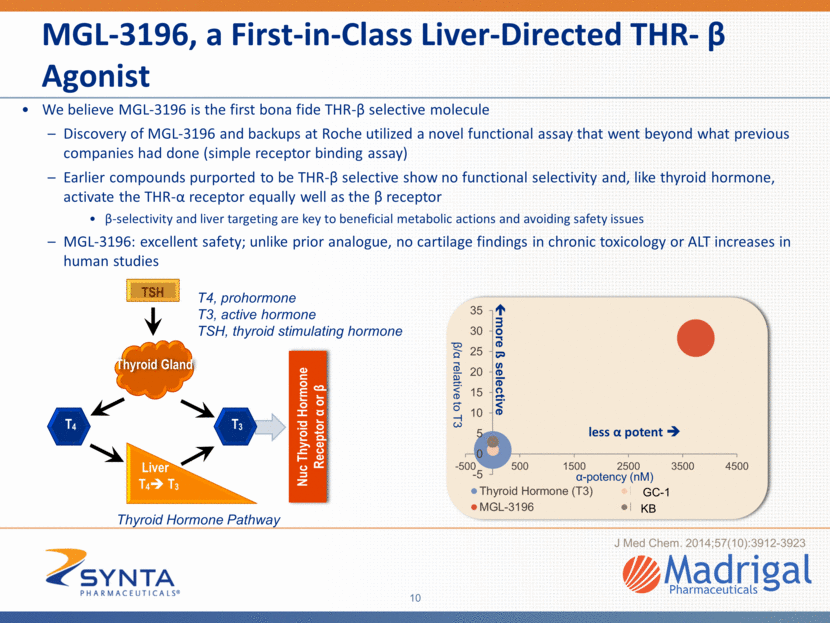
Madrigal Pipeline Compound/Target Disease State Pre-Clinical Phase 1 Phase 2 Phase 3 MGL-3196 Thyroid Hormone Receptor-β (THR-β) Agonist NASH FH MGL-3745 Thyroid Hormone –Receptor-β (THR-β) Agonist (Backup) (Same as 3196) Thyroid analogue platform (MGL-3196, backup, new molecules) Biliary disorders (progressive familial intrahepatic cholestasis-PFIC) Subclinical hypothyroidism Genetic dyslipidemias Orphan thyroid diseases, RTH, MCT8 deficiency: new molecule, brain penetrant Nature Rev. Endocrinol. 10, 164, 2014
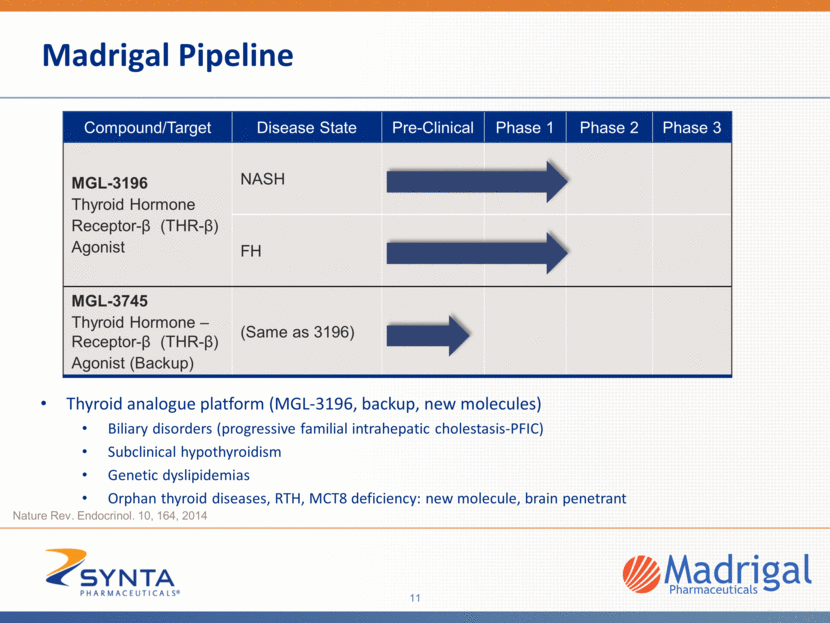
Differentiated NASH Opportunity Large & Growing Unserved Market Note: Market size statistics sourced from various Wall Street equity research. Unique & Differentiated Approach Defined, Regulatory Path WW NASH market estimated at $35bn-$40bn While epidemiology data varies, ~2-3% of the US population is thought to have NASH, and expected to grow given the high rate of growth of obesity and diabetes No FDA approved treatment options MGL-3196 is a novel differentiated cardio-protective therapy Strong disease link: THR-β receptor activity is deficient in NASH livers Supported by preclinical and clinical data Differentiation: CV benefit, MGL-3196 LDL cholesterol lowering up to 30% in humans Critical differentiation in NASH, a disease more likely to lead to death by cardiovascular disease than liver disease Treating NASH, rather than fibrosis, is key to addressing the disease Recent FDA guidance indicates that resolution of NASH, without reducing fibrosis, is an approvable endpoint Recognition that liver fibrosis will decrease with time after NASH resolves (similar to reduction of fibrosis as the liver regenerates after cure of HCV)

THR-β Benefits Across the Spectrum of Early to Advanced NASH Evidence from human and animal data from Madrigal and multiple published studies METABOLIC BENEFITS liver fat & lipotoxicity insulin sensitivity LDL cholesterol atherosclerosis NASH inflammation and fibrosis Fatty Liver Cirrhosis Normal Liver ANTI-INFLAMMATORY ANTI-FIBROTIC apoptosis, liver enzymes regeneration fibrosis & inflammation Hepatology. 2009;49(2):407-417; FASEB J. 2008;22(8):2981-2989; Taub et al,, So et al, unpub; Trends Endocrinol Metab. 2014;25(10):538-545PLoS One. 2010;5(1):e8710 Toxicol Pathol. 2003;31(1):113-120; J REDUCED NASH COMPLICATIONS CV disease HCC Lipid Res. 2014;55(11):2408-2415 ; Endocrinology. 2014;155(11):4591-4601; PLoS One. 2013;8(12):e78534 Effects of MGL-3196:
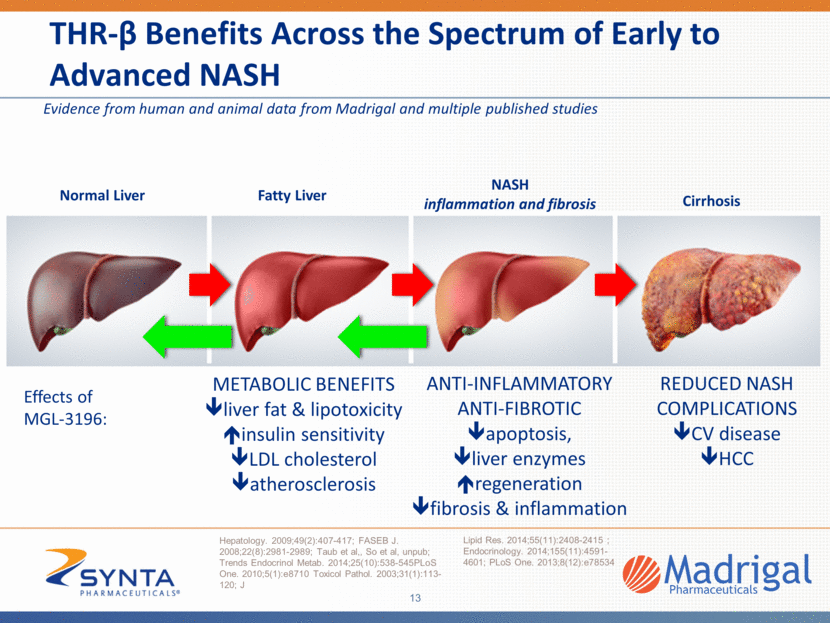
MGL-3196: Marked and Rapid Improvement in Liver Health Upper panels: 24d study in 17 wk old DIO mice (po, qd) on high fat diet (HFD) 13 wks; lower panels: 24d study in 40 wk old DIO mice on HFD 35 wks Liver Size ** ** * MGL-3196 * ** ** Liver Triglycerides *** p<0.001 ** p<0.01* p<0.05 Liver Fat (Histology) Insulin Tolerance Test (0.5 U/kg insulin) * * * * * p<0.05 * ALT *** *** *** *** MGL-3196 Reduced hepatic triglycerides (>50%), normalized liver size Insulin sensitivity improved at all doses Reduced liver enzymes (ALT, AST) Improved liver histology, reduced NASH score Control 0 20 40 60 80 100 120 0 60 120 % T i m e 0 G l u c o s e T i m e , (m i n ) C o n tr o l MG L -3 1 9 6 . 3 m g / k g MG L -3 1 9 6 1 m g / k g MG L -3 1 9 6 3 m g / k g R o s i g l i ta zo n e : 1 0 m g / k g 0 20 40 60 80 100 120 0 60 120 % T i m e 0 G l u c o s e T i m e , (m i n ) C o n tr o l MG L -3 1 9 6 . 3 m g / k g MG L -3 1 9 6 1 m g / k g MG L -3 1 9 6 3 m g / k g R o s i g l i ta zo n e : 1 0 m g / k g 0 1 2 3 4 5 L i v e r % B o d y W e i g h t 0 10 20 30 40 50 60 70 T r i g l y c e r i d e s m g / g 0 50 100 150 200 250 300 I U / L C o n tr o l MG L -3 1 9 6 . 3 m g / k g MG L -3 1 9 6 1 m g / k g MG L -3 1 9 6 3 m g / k g MG L -3 1 9 6 1 0 m g / k g
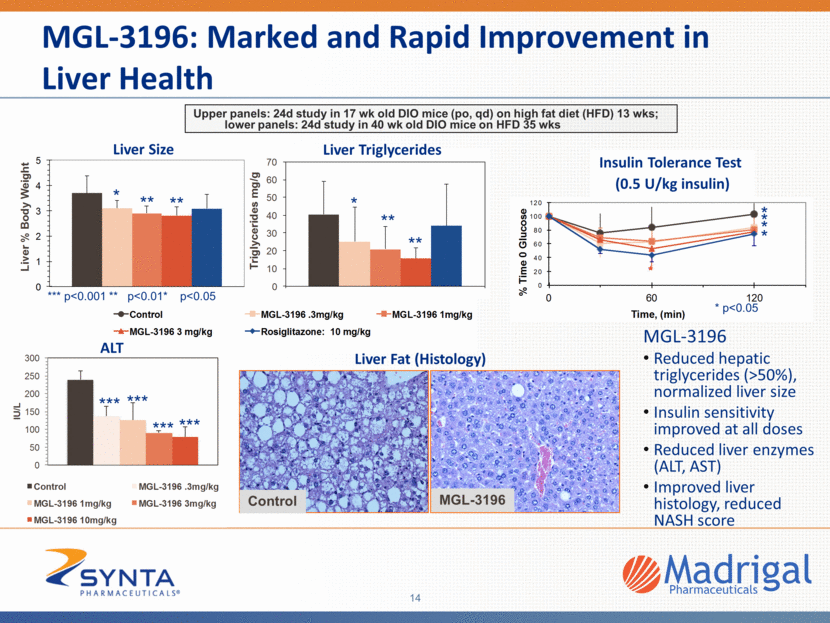
MGL-3196: Reduction of Key NASH, Fibrosis Pathway Genes at Human Comparable Drug Levels TIMP1 tissue inhibitor metalloproteinase CTGF connective tissue growth factor SMA smooth muscle actin SAA serum amyloid A CRP C-reactive protein “HFD”, lane 1 mean HFD gene expression normalized to mean Lean; Lanes (2-7) mean gene expression normalized to mean of DIO; “Rosi” (rosiglitazone, 3 mg/kg, 24 wks) Red, higher expression; blue decreased expression Inflammation HFD Lean 0.1 0.3 1 3 Rosi MCP-1/CCL2 MIP-2α/CXCL2 MIP-2ß/CXLCL3 A20/TNFaip3 CRP Annexin 2 SAA1 Fibrosis Collagen 1 Galectin-3 TIMP1 Collagen 4a2 SMA Collagen 4a1 CTGF Keratin 18 Collagen 3 Galectin-1 HFD mouse model Up-regulation of NASH and fibrosis related transcripts in HFD as compared with lean mice controls Effects of MGL-3196 in 25 week HFD mouse model Downregulation of key NASH, inflammation and fibrosis pathway genes Reduced to lean mouse level Highly statistically significant Reduction of ALT More improvement than rosiglitazone Rosiglitazone has been shown to be modestly efficacious in human NASH (HEPATOLOGY 2011;54:1631-1639) Drug exposures at .3-1 mg/kg in HFD mice are similar to human dose where maximum lipid lowering is observed Maximum efficacy ~ .3-1 mg/kg in 25 week study 25 week study in DIO, lean control mice and HFD mice treated with 0.1 to 3 mg/kg MGL-3196 or Rosiglitazone (3mg/kg) Bad Good 1 2 3 4 5 6 7 MGL-3196 (mg/kg)
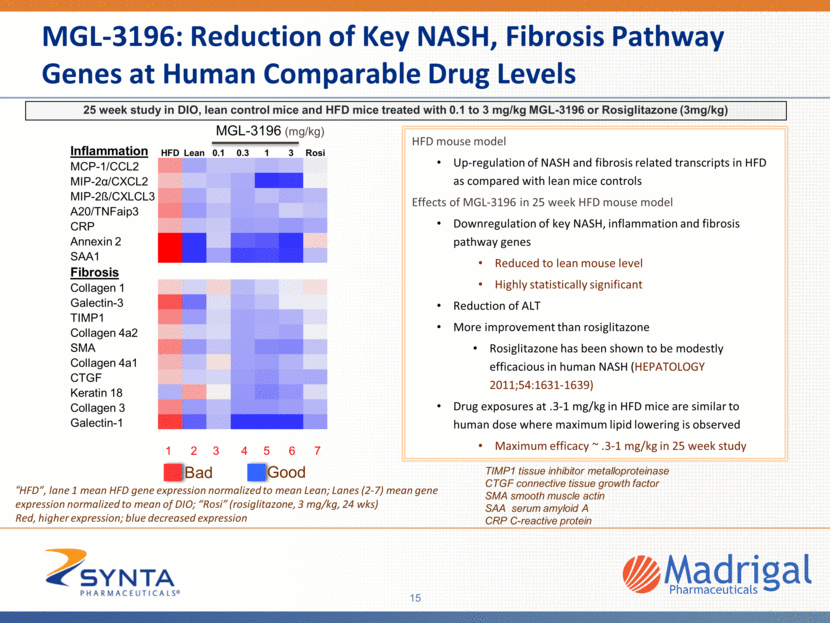
MGL-3196: Robust LDL and Triglyceride Lowering in 14 Day Multiple Dose Phase 1 Study Once daily oral treatment led to highly significant and dose-dependent up to ~30% reduction of apolipoprotein B (ApoB), total, LDL, non-HDL cholesterol; Strong trends in triglyceride reduction up to 60%; Near maximal effect at 80mg dose Change from Baseline (CFB) by mean % CFB calculated for each individual subject 24h after 14th dose; baseline value obtained just prior to first dose; ApoB, apolipoprotein B; Chol, total cholesterol; LDL-C, LDL cholesterol directly measured; Non-HDL-C, non-HDL cholesterol; TG, triglycerides (median %CFB) *** p<0.001 ** p<0.01 * p<0.05 “p<0.1 *** *** *** *** *** *** *** ** ** ** ** ** ** * * * * “ “
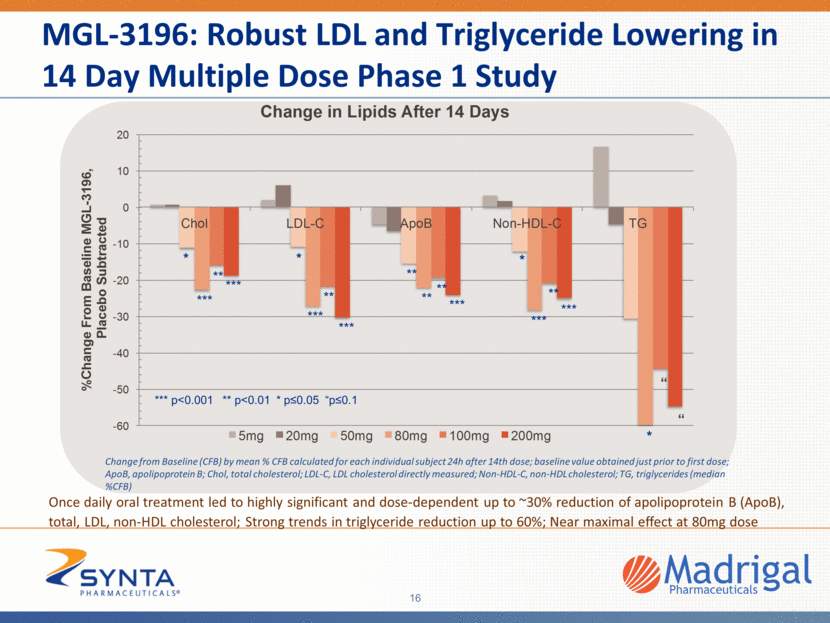
Strong Positioning in NASH Landscape Compound Phase NAS Score Fibrosis Score Liver Lipids NASH Prevention Insulin Sensitivity LDL TGs CV Risk Side Effects MGL-3196 1 CV Benefit Well-tolerated Benefit Small benefit Green = Good Decrease Pleiotropic and cardio-beneficial actions position MGL-3196 as potential best-in-class NASH therapeutic Metabolic regulator, reduces lipotoxicity, the driver of NASH and fibrosis Cardiovascular disease is the number one killer of NASH patients MGL-3196 potently reduces LDL-C and TGs Opportunities for differentiation from other NASH agents Intercept’s OCA elevates LDL-C, potentially raising the regulatory bar for approval and limiting the market opportunity Elafibrinor demonstrates modest reduction in LDL-C Anti-fibrotics do not address underlying cause of NASH Efficacy on NASH and cardiovascular endpoints position MGL-3196 as an ideal NASH drug to be used in combination with anti-fibrotic and/or anti-inflammatory agents Lancet 385:956-65; 2015 Gastroenterology Feb 11 2016; pii:S0016-5085(10)00140-2
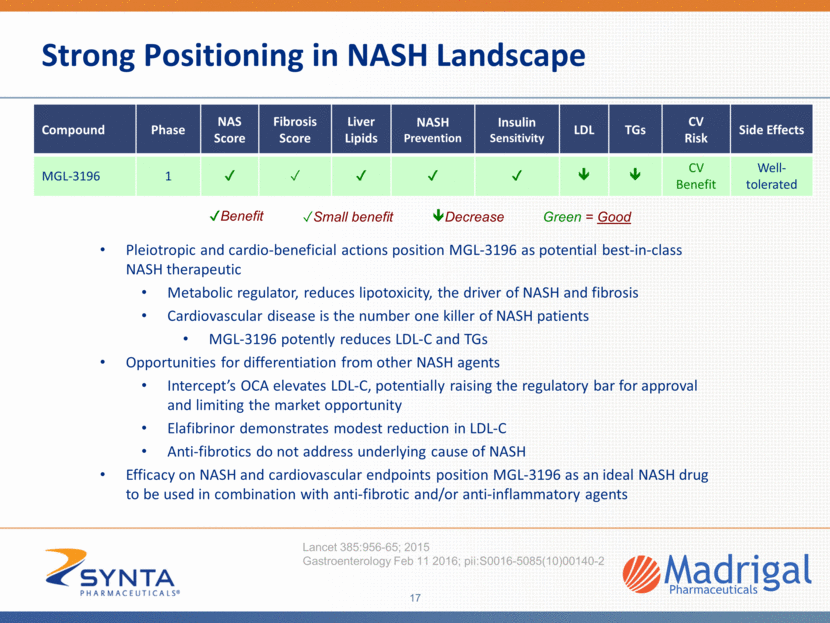
Unmet Needs in FH, a Severe Genetic Dyslipidemia HeFH and HoFH caused primarily by inactivating mutations in LDL receptor Early onset cardiovascular disease, HoFH < age 20 Severe Debilitating Dyslipidemia Novel Therapeutic Approaches Needed 1/200-1/500 HeFH; 1/250,000-1/1,000,000 HoFH Higher frequency in certain genetically homogeneous populations Prevalence Despite current and newer therapies (i.e. PCSK9 ab), HoFH and many HeFH (severe HeFH) not achieving treatment goals Significant commercial opportunity for MGL-3196 in HoFH, refractory HeFH European Heart Journal doi:10.1093/eurheartj/ehu274; 2014
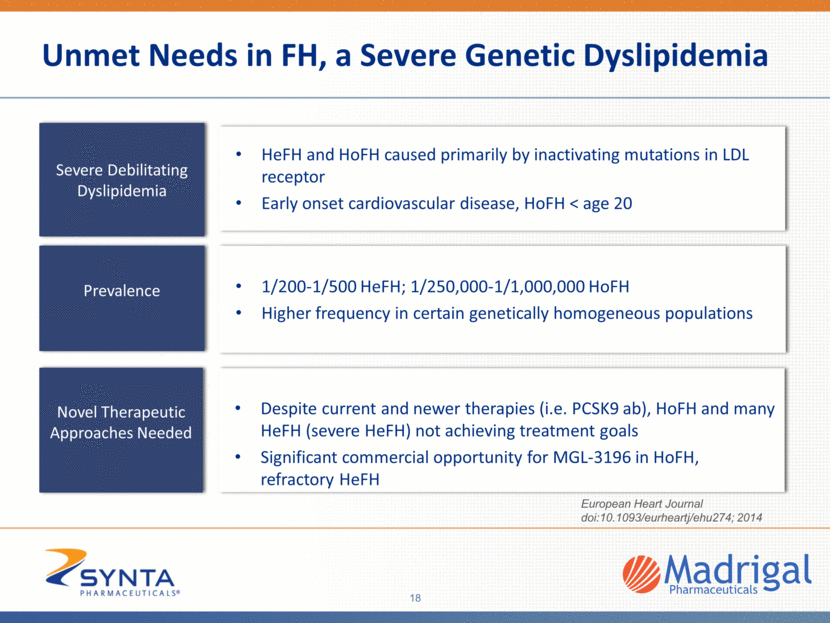
MGL-3196: Unique and Complementary Lipid Lowering Profile Thyroid pathway clinically validated and differentiated in FH MGL-3196 lowers LDL in concert with statins in clinical, preclinical studies In Phase 3 trials in HeFH, earlier THR agonist lowered LDL cholesterol and Lp(a)* Thyroid agonists lower cholesterol in LDL receptor knockout mice MGL-3196 is one of the only mechanisms that lowers Lp(a) Lp(a) is a severely atherogenic particle that is elevated in FH and not well-treated by existing therapeutics MGL-3196 *Lancet Diabetes Endocrinol2014; 2: 455–63 *Endocrinology 2012 Nov;153(11):5143-9 both LDL receptor dependent and independent cholesterol lowering ApoB Lp(a) Cholesterol Breakdown Elimination
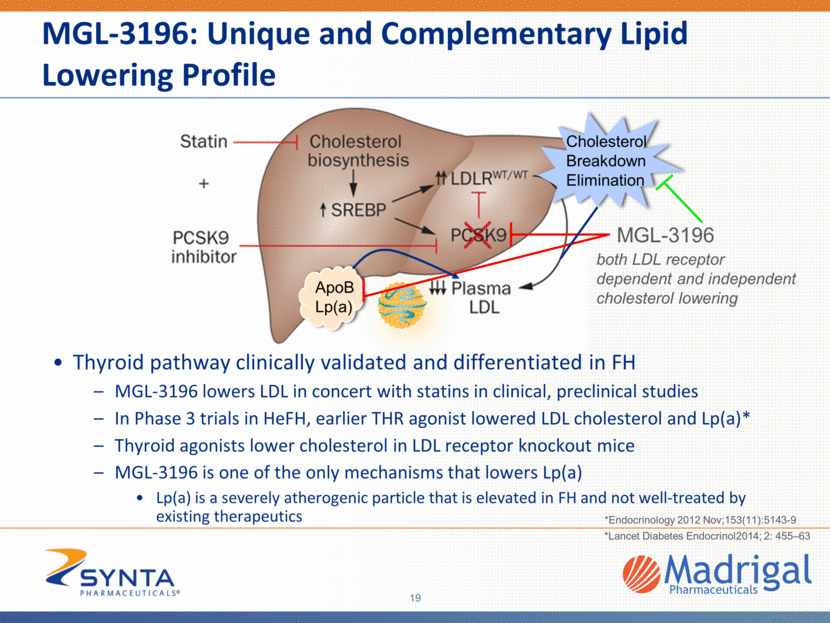
2018 Potential Near and Long-term Value Drivers 2017 2016 2015 Completion of MGL-3196 long-term toxicology studies MGL-3196 dosed with statins in Ph1 study HeFH Ph 2 HoFH Ph2a NASH Ph2 Data on HeFH Ph2 HoFH Ph2a Data on NASH Ph2 1oEndpoint Liver Fat Biomarkers Start of HoFH & HeFH Ph3 Data on NASH Ph2 Liver Biopsy Clinical Trial Start Data Filing 50% HeFH treated Interim safety, efficacy Topline FH data NASH topline 3 mo data NASH topline 6 mo

Thank you NASDAQ: SNTA April 14, 2016

